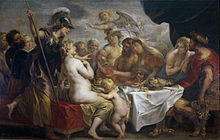Judgement of Paris
The brief allusion to the Judgement in the Iliad (24.25–30) shows that the episode initiating all the subsequent action was already familiar to its audience; a fuller version was told in the Cypria, a lost work of the Epic Cycle, of which only fragments (and a reliable summary[2]) remain.The later writers Ovid (Heroides 16.71ff, 149–152 and 5.35f), Lucian (Dialogues of the Gods 20), Pseudo-Apollodorus (Bibliotheca, E.3.2) and Hyginus (Fabulae 92), retell the story with skeptical, ironic or popularizing agendas.It appeared wordlessly on the ivory and gold votive chest of the 7th-century BC tyrant Cypselus at Olympia, which was described by Pausanias as showing: ... Hermes bringing to Alexander [i.e. Paris] the son of Priam the goddesses of whose beauty he is to judge, the inscription on them being: 'Here is Hermes, who is showing to Alexander, that he may arbitrate concerning their beauty, Hera, Athena and Aphrodite.They asked Zeus to judge which of them was fairest, and eventually he, reluctant to favour any claim himself, declared that Paris, a Trojan mortal, would judge their cases, for he had recently shown his exemplary fairness in a contest in which Ares in bull form had bested Paris's own prize bull, and the shepherd-prince had unhesitatingly awarded the prize to the god.[12] As a subject for easel paintings, it was more common in Northern Europe, although Marcantonio Raimondi's engraving of c. 1515, probably based on a drawing by Raphael, and using a composition derived from a Roman sarcophagus, was a highly influential treatment, which made Paris's Phrygian cap an attribute in most later versions.Later artists who have painted the subject include André Lhote, Enrique Simonet (El Juicio de Paris 1904), and Salvador Dalí.Ivo Saliger (1939), Adolf Ziegler (1939), and Joseph Thorak (1941) also used the classic myth to propagate German renewal during the Nazi period.The opera Le Cinesi (The Chinese Women) by Christoph Willibald Gluck (1754) concludes with a ballet, The Judgement of Paris, sung as a vocal quartet.The story is the basis of an earlier opera, Il pomo d'oro, in a prologue and five acts by the Italian composer Antonio Cesti, with a libretto by Francesco Sbarra (1611–1668).









Judgement of Paris (disambiguation)PompeiiTrojan WarAchillesPatroclusAttic red-figure kylixEpic CycleAeneid, Book 2Iphigenia in AulisPhiloctetesThe Trojan WomenPosthomericaTrojan War in literature and the artsTrojan HorseSack of TroyThe ReturnsWanderings of OdysseusAeneas and the Founding of RomeAgamemnonMenelausNestorOdysseusDiomedesThersitesAchaeansMyrmidonsAchaean LeadersCatalogue of ShipsHecubaHectorCassandraAndromacheAeneasMemnonTroilusPenthesileaAmazonsSarpedonTrojan Battle OrderTrojan LeadersAthenaHephaestusHermesThetisPoseidonAphroditeApolloArtemisScamanderAhhiyawaAlaksanduAttarsiyaHisarlıkHomeric QuestionLate Bronze Age TroyManapa-Tarhunta letterMilawata letterTawagalawa letterTrojan languageWilusaHistoricity of the IliadBronze Age CollapseEuhemerismMycenaeGreek mythologyPeleusgolden appleParis of TroybribedHelen of SpartaApple of Discordcasus belliSwing PainterMetropolitan Museum of ArtCyprialost workLucianPseudo-ApollodorusBibliothecaHyginusCypselusOlympiaPausaniasAlexanderRenaissanceJacob JordaensmarriageGarden of the HesperidesHendrick van Balen the ElderGemäldegalerie, BerlinMount IdaCharitesAthenagoras of AthensEuripidesSpartaHelen of TroyironicJoachim Wtewaelfeast of the godssexualityLucas Cranach the ElderSaint Louis Art MuseumMiddle Agesilluminated manuscriptsmaiolicacassoniMarcantonio RaimondiengravingRaphaelsarcophagusPhrygian capNorthern ManneristRubensseveral compositionsWatteauAngelica Kauffmanacademic artistsRenoirCézanneAndré LhoteEnrique SimonetEl Juicio de ParisSalvador DalíSimon VouetThe Judgement of Parislibretto